The Unified Network Management Market is estimated to be valued at USD 108.3 billion in 2025 and is projected to reach USD 337.6 billion by 2035, registering a compound annual growth rate (CAGR) of 12.0% over the forecast period.
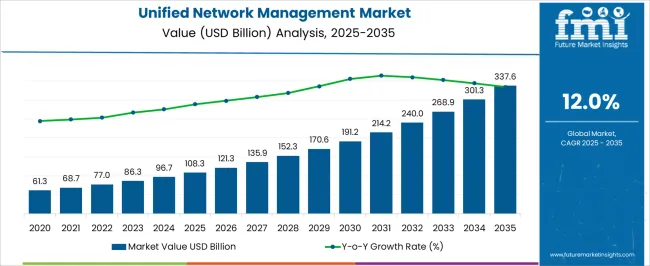
| Metric | Value |
|---|---|
| Unified Network Management Market Estimated Value in (2025 E) | USD 108.3 billion |
| Unified Network Management Market Forecast Value in (2035 F) | USD 337.6 billion |
| Forecast CAGR (2025 to 2035) | 12.0% |
The Unified Network Management market is experiencing strong growth, driven by the increasing complexity of enterprise networks and the rising need for integrated monitoring, management, and optimization solutions. Organizations are increasingly adopting unified platforms to consolidate network visibility, improve operational efficiency, and enhance performance across multi-vendor environments. Growth is further supported by the proliferation of cloud services, software-defined networking, and IoT deployments, which increase network traffic and require advanced management tools.
Investments in cybersecurity and regulatory compliance are also driving the adoption of comprehensive network management systems that provide centralized monitoring, automated alerts, and actionable analytics. Training and support services are being leveraged to maximize operational effectiveness and ensure optimal use of network solutions.
As enterprises prioritize network reliability, scalability, and automation, the Unified Network Management market is expected to sustain long-term growth Continuous innovation in software platforms, predictive analytics, and AI-driven monitoring capabilities is creating additional opportunities for efficiency improvements, cost savings, and enhanced decision-making across enterprise IT infrastructures.
The unified network management market is segmented by service type, solution type, end-user type, application, and geographic regions. By service type, unified network management market is divided into Training And Support, Consulting, Managed And Integration Service, and Others. In terms of solution type, unified network management market is classified into Network Monitoring Management, Configuration And Server Management, Network Security Management, Network Traffic Management, Network Application Management, and Others. Based on end-user type, unified network management market is segmented into Large Enterprises, Small And Medium Enterprises, and Others. By application, unified network management market is segmented into BFSI, Retail And Consumer Goods, High-Tech And Telecom, Travel And Hospitality, Government, Media And Entertainment, Healthcare, Education, and Others. Regionally, the unified network management industry is classified into North America, Latin America, Western Europe, Eastern Europe, Balkan & Baltic Countries, Russia & Belarus, Central Asia, East Asia, South Asia & Pacific, and the Middle East & Africa.
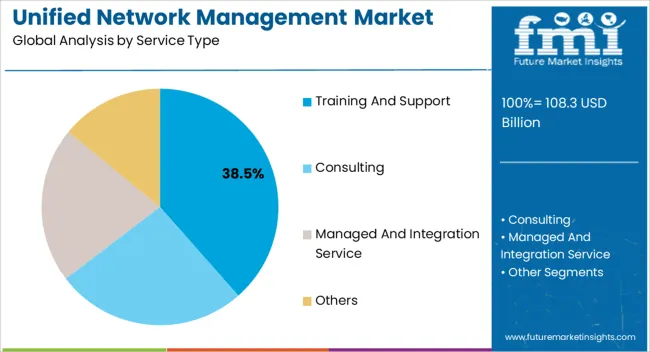
The training and support service type segment is projected to hold 38.5% of the market revenue in 2025, establishing it as the leading service type. Growth in this segment is being driven by the increasing complexity of network environments, which necessitates comprehensive training programs and technical support for IT teams. These services enable organizations to maximize the value of their unified network management platforms, ensuring efficient configuration, monitoring, and troubleshooting.
Training and support help reduce operational errors, enhance response times, and improve overall network performance. The integration of AI and automation within network management solutions requires skilled personnel, further emphasizing the importance of this segment. Organizations are leveraging training programs to upskill employees and ensure compliance with best practices and security protocols.
The availability of scalable and customized support solutions strengthens adoption, reduces downtime, and enhances system reliability As enterprises expand and modernize their IT infrastructures, the training and support service type segment is expected to remain the primary contributor to market revenue, driven by operational efficiency and continuous technological advancements.
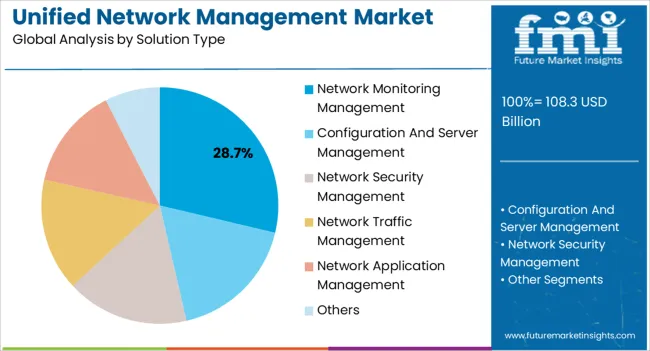
The network monitoring management solution type segment is anticipated to account for 28.7% of the market revenue in 2025, making it the leading solution type. Growth in this segment is being driven by the need for real-time visibility into network performance, proactive fault detection, and efficient bandwidth utilization. Network monitoring management solutions allow IT teams to identify bottlenecks, optimize traffic flow, and prevent service disruptions through predictive analytics and automated alerts.
Integration with cloud platforms and multi-vendor networks enhances operational flexibility and reduces management complexity. Organizations are increasingly adopting these solutions to maintain high service levels, improve user experience, and support digital transformation initiatives. Advanced reporting, dashboards, and AI-driven insights provide actionable intelligence for decision-making and long-term network planning.
The scalability, reliability, and automation offered by network monitoring management solutions strengthen their market position As enterprises continue to expand network capacity and implement new technologies, this segment is expected to remain a key driver of market growth.
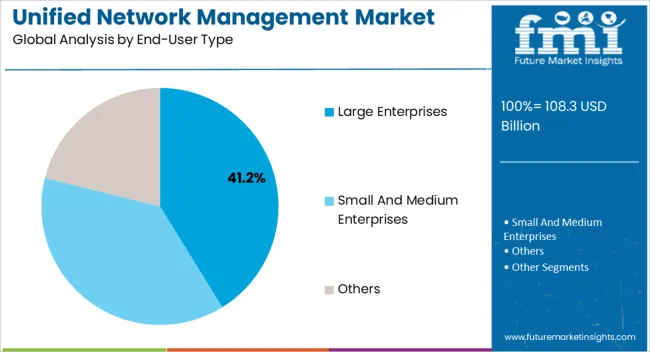
The large enterprises end-user type segment is expected to hold 41.2% of the market revenue in 2025, positioning it as the leading end-user category. Growth in this segment is driven by the increasing reliance of large organizations on complex and geographically dispersed networks, which require centralized monitoring and management solutions. Large enterprises face higher demands for operational efficiency, security, and regulatory compliance, making unified network management solutions critical for minimizing downtime and ensuring consistent performance.
The adoption of cloud services, IoT devices, and hybrid IT infrastructures has further accelerated demand in this segment. Large organizations are leveraging these solutions to consolidate network management, gain real-time insights, and enhance decision-making capabilities.
Training and support services, along with network monitoring management solutions, are widely adopted to improve staff capabilities and operational reliability As large enterprises continue to modernize and scale their IT environments, their reliance on unified network management platforms is expected to drive sustained market growth, reinforced by ongoing technological innovation and integration capabilities.
Valued at US$ 77 Billion in FY2025, the unified network management market is forecast to reach US$ 86.27 Billion in 2025. From 2025 to 2035, a CAGR of 12.04% is predicted for the industry. By the end of the said period of assessment, sales are expected to generate US$ 268.89 Billion in revenue. Demand is expected to proliferate due to rising usage of connected devices and complex servers to conduct daily business and commercial operations.
A unified network integrates wireless and wired components sharing services and network elements where viable, rather than prevailing as two distinct networks. Unified network management offerings make mutual network functions controllable from a single support. These unified network management functions include provisioning, planning, arranging, monitoring (such as security, performance, and integrity monitoring), logging handling exceptions, and reporting.
The unified network management console also comprises of essentials that are distinctive to wireless management, including spectrum management and monitoring, connection reliability, tracking and location functionality, and other relevant security issues. Unified networking management follows an industry trend as a way to deal with an increasingly mobile workforce accessing corporate networks remotely through a variety of devices, including tablets and smartphones as well as desktop computers and notebooks.
When network management functions are separated, understanding service impact is challenging. It takes an inordinate amount of time swivelling from tool to tool to troubleshoot and remediate network issues. Hence, unified network management solutions are being deployed across all major end-use industries. Following the trend of network convergence, unified management can be applied in various networking scenarios, thus simplifying network roll-out through centralized deployment and auto-discovery capabilities, and network operation via advanced correlation rules and end-to-end performance management.
| Data Points | Key Statistics |
| Market Value of Unified Network Management in 2025 | US$ 77 Billion |
| Expected Market Value of Unified Network Management in 2025 | US$ 86.27 Billion |
| Projected Value of the Unified Network Management Market in 2035 | US$ 268.89 Billion |
| Global Growth Rate (2025 to 2035) | 12.04% CAGR |
Unified network management is especially finding applications in mitigating cybersecurity risks and threats. This unified threat management involves deployment and management of antivirus software, content filtering, email and web filtering and developing anti-spam frameworks. In today’s virtual landscape, cybercrime is on the rise, with over 75% of them beginning via emails. As of 2025, the USA Federal Bureau of Investigation received over 15,000 internet crime complaints related to tech support fraud, from victims across 60 countries. Recent cybersecurity incidents show that it’s not just user data cybercriminals are after. Instead, they’re wreaking havoc on infrastructures like hospitals, pipelines, meatpacking plants, and water supply centres.
It is anticipated that by 2025, global cybercrime costs are anticipated to rise by 15% annually, reaching US$ 10.5 Trillion. Out of all industries, healthcare is expected to be the most important area for cybercrime and threat detection, with expenditures expected to reach US$ 125 Billion over the next half-a-decade. Thus, the need for unified network management frameworks to mitigate threats will rise phenomenally across the healthcare sector.
While North America will retain the top spot in unified network management, Asia Pacific is expected to generate a plethora of opportunities for key service providers. This is because a large part of businesses across industries are outsourced from the West to Asia, especially to China and India. Naturally, organizations have beefed up their network management frameworks, requiring deployment of advanced unified network management solutions.
Today’s networks need to support more traffic than ever. Employees access corporate data from desktops and mobile devices. Internet of Things devices proliferate everywhere on premises. Hence, risks of increased maintenance of servers, poor network connectivity, configuration issues and security compromises are expected to become prevalent. This is one major factor which is likely to stymie expansion of the unified network management industry.
Unified network integrates wireless and wired components and share services and network elements where viable, rather than prevailing as two distinct networks. Unified network management offerings make mutual network functions controllable from a single support. These unified network management functions include provisioning, planning, arranging, monitoring (such as security, performance, and integrity monitoring), logging handling exceptions, and reporting.
The unified network management console also comprises of essentials that are distinctive to wireless management, including spectrum management and monitoring, connection reliability, tracking and location functionality, and other relevant security issues. Unified networking management follows an industry trend as a way to deal with an increasingly mobile workforce accessing corporate networks remotely through a variety of devices, including tablets and smartphones as well as desktop computers and notebook.
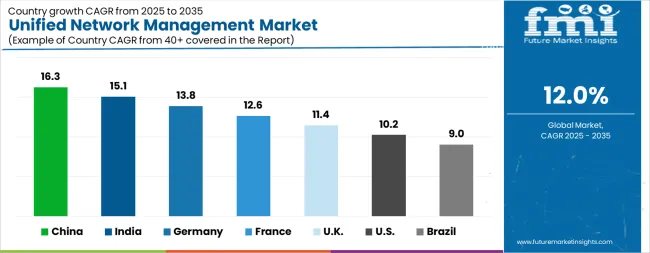
| Country | CAGR |
|---|---|
| China | 16.3% |
| India | 15.1% |
| Germany | 13.8% |
| France | 12.6% |
| UK | 11.4% |
| USA | 10.2% |
| Brazil | 9.0% |
The Unified Network Management Market is expected to register a CAGR of 12.0% during the forecast period, exhibiting varied country level momentum. China leads with the highest CAGR of 16.3%, followed by India at 15.1%. Developed markets such as Germany, France, and the UK continue to expand steadily, while the USA is likely to grow at consistent rates. Brazil posts the lowest CAGR at 9.0%, yet still underscores a broadly positive trajectory for the global Unified Network Management Market. In 2024, Germany held a dominant revenue in the Western Europe market and is expected to grow with a CAGR of 13.8%. The USA Unified Network Management Market is estimated to be valued at USD 39.9 billion in 2025 and is anticipated to reach a valuation of USD 105.6 billion by 2035. Sales are projected to rise at a CAGR of 10.2% over the forecast period between 2025 and 2035. While Japan and South Korea markets are estimated to be valued at USD 5.8 billion and USD 3.1 billion respectively in 2025.
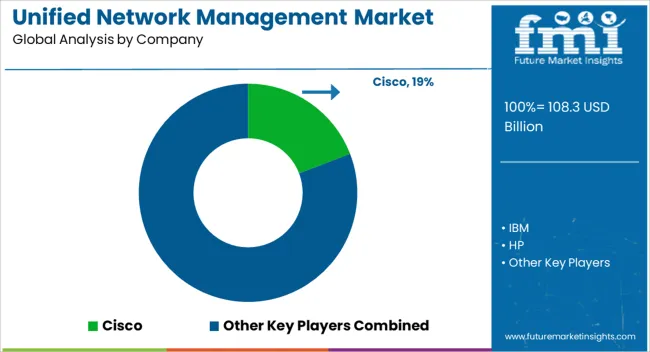
| Item | Value |
|---|---|
| Quantitative Units | USD 108.3 Billion |
| Service Type | Training And Support, Consulting, Managed And Integration Service, and Others |
| Solution Type | Network Monitoring Management, Configuration And Server Management, Network Security Management, Network Traffic Management, Network Application Management, and Others |
| End-User Type | Large Enterprises, Small And Medium Enterprises, and Others |
| Application | BFSI, Retail And Consumer Goods, High-Tech And Telecom, Travel And Hospitality, Government, Media And Entertainment, Healthcare, Education, and Others |
| Regions Covered | North America, Europe, Asia-Pacific, Latin America, Middle East & Africa |
| Country Covered | United States, Canada, Germany, France, United Kingdom, China, Japan, India, Brazil, South Africa |
| Key Companies Profiled | Cisco, IBM, HP, Huawei, Ericsson, Alcatel-Lucent, Avaya, Juniper Networks, CA Technologies, and EMC |
The global unified network management market is estimated to be valued at USD 108.3 billion in 2025.
The market size for the unified network management market is projected to reach USD 337.6 billion by 2035.
The unified network management market is expected to grow at a 12.0% CAGR between 2025 and 2035.
The key product types in unified network management market are training and support, consulting, managed and integration service and others.
In terms of solution type, network monitoring management segment to command 28.7% share in the unified network management market in 2025.






Our Research Products

The "Full Research Suite" delivers actionable market intel, deep dives on markets or technologies, so clients act faster, cut risk, and unlock growth.

The Leaderboard benchmarks and ranks top vendors, classifying them as Established Leaders, Leading Challengers, or Disruptors & Challengers.

Locates where complements amplify value and substitutes erode it, forecasting net impact by horizon

We deliver granular, decision-grade intel: market sizing, 5-year forecasts, pricing, adoption, usage, revenue, and operational KPIs—plus competitor tracking, regulation, and value chains—across 60 countries broadly.

Spot the shifts before they hit your P&L. We track inflection points, adoption curves, pricing moves, and ecosystem plays to show where demand is heading, why it is changing, and what to do next across high-growth markets and disruptive tech

Real-time reads of user behavior. We track shifting priorities, perceptions of today’s and next-gen services, and provider experience, then pace how fast tech moves from trial to adoption, blending buyer, consumer, and channel inputs with social signals (#WhySwitch, #UX).

Partner with our analyst team to build a custom report designed around your business priorities. From analysing market trends to assessing competitors or crafting bespoke datasets, we tailor insights to your needs.
Supplier Intelligence
Discovery & Profiling
Capacity & Footprint
Performance & Risk
Compliance & Governance
Commercial Readiness
Who Supplies Whom
Scorecards & Shortlists
Playbooks & Docs
Category Intelligence
Definition & Scope
Demand & Use Cases
Cost Drivers
Market Structure
Supply Chain Map
Trade & Policy
Operating Norms
Deliverables
Buyer Intelligence
Account Basics
Spend & Scope
Procurement Model
Vendor Requirements
Terms & Policies
Entry Strategy
Pain Points & Triggers
Outputs
Pricing Analysis
Benchmarks
Trends
Should-Cost
Indexation
Landed Cost
Commercial Terms
Deliverables
Brand Analysis
Positioning & Value Prop
Share & Presence
Customer Evidence
Go-to-Market
Digital & Reputation
Compliance & Trust
KPIs & Gaps
Outputs
Full Research Suite comprises of:
Market outlook & trends analysis
Interviews & case studies
Strategic recommendations
Vendor profiles & capabilities analysis
5-year forecasts
8 regions and 60+ country-level data splits
Market segment data splits
12 months of continuous data updates
DELIVERED AS:
PDF EXCEL ONLINE
Network Management System Market Insights - Growth & Forecast through 2034
Network Management Solutions Market
IoT Network Management Market Size and Share Forecast Outlook 2025 to 2035
Unified Endpoint Management Market Size and Share Forecast Outlook 2025 to 2035
Active Network Management Market Analysis by Component, End Users, and Region Through 2025 to 2035
Network Security Policy Management Market Size and Share Forecast Outlook 2025 to 2035
Network Simulator Software Market Size and Share Forecast Outlook 2025 to 2035
Network Connectivity Tester Market Size and Share Forecast Outlook 2025 to 2035
Unified Communications and Collaboration Market Size and Share Forecast Outlook 2025 to 2035
Network Analyzers Market Size and Share Forecast Outlook 2025 to 2035
Network as a Service (NaaS) Market Size and Share Forecast Outlook 2025 to 2035
Network Analytics Market Size and Share Forecast Outlook 2025 to 2035
Network Devices Market Size and Share Forecast Outlook 2025 to 2035
Network Sandboxing Market Size and Share Forecast Outlook 2025 to 2035
Network Access Control (NAC) Market Size and Share Forecast Outlook 2025 to 2035
Network Monitoring Market Size and Share Forecast Outlook 2025 to 2035
Network Encryption Market Size and Share Forecast Outlook 2025 to 2035
Network Packet Broker Market Size and Share Forecast Outlook 2025 to 2035
Network Traffic Analytics Market Size and Share Forecast Outlook 2025 to 2035
Network Function Virtualization (NFV) Market Size and Share Forecast Outlook 2025 to 2035

Thank you!
You will receive an email from our Business Development Manager. Please be sure to check your SPAM/JUNK folder too.
Chat With
MaRIA